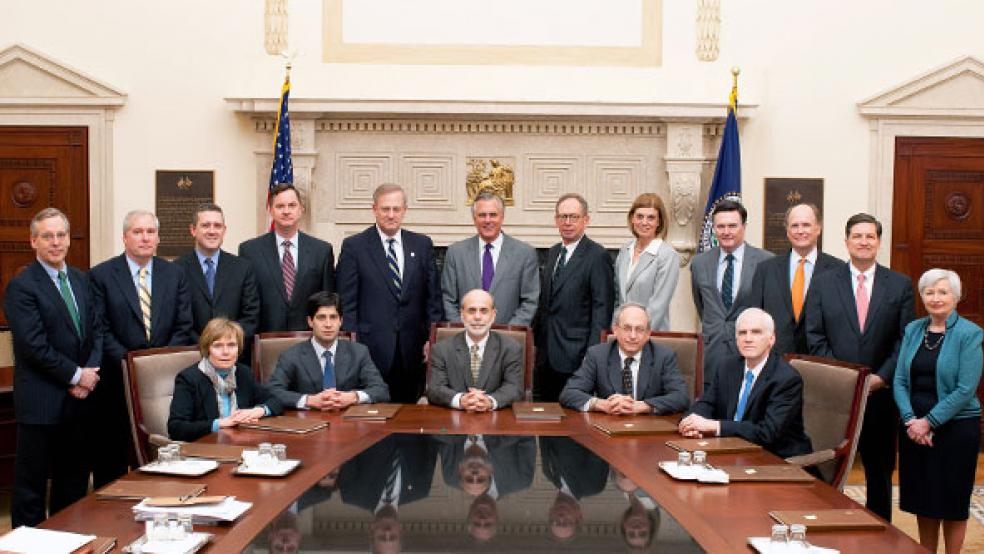|
Policymakers at the Federal Reserve are increasingly talking about tightening their ultra-easy monetary policy, which has kept interest rates near zero since 2008. Based on minutes from their April policy meeting, released last week, they are starting to lay out details of a so-called exit strategy from the unconventional measures taken in recent years, actions that have both supported the economy and raised fears of future inflation. But that doesn’t mean they are about to start down the path toward higher interest rates anytime soon.
Fed officials went out of their way to say that talking about normalizing policy “did not mean that the move to such normalization would necessarily begin soon.” In fact, there is a new wild card in the mix. The timing of any Fed action is becoming increasingly dependent on fiscal policy, especially how the drama over the debt ceiling and the budget battle plays out. Several possible scenarios suggest outcomes that could keep Fed policy on hold for a long time—perhaps even longer than Wall Street now expects.

The minutes listed “fiscal contraction” as one factor already in the pipeline that will limit the pace of economic growth, as federal stimulus from the recovery act and other programs wanes. Decisions on fiscal policy in coming months could only add to that drag. Given the polarized political climate, Washington’s fiscal head-butting could end up any number of ways. As a way of thinking about what’s at stake for the economy and how the ultimate resolution could affect Federal Reserve policy, here’s a look at three pertinent scenarios.
Scenario 1—Political Intransigence (Nothing Gets Done)
This is the high-stakes outcome economists fear most in which the White House and Congress play their game of chicken all the way past the new early-August deadline for raising the debt limit. That’s when Treasury runs out of its $200 billion, or so, in easy options for staying under the $14.294 trillion limit. After that, forced asset sales could disrupt markets, and the risk of a U.S. default would rise sharply. Fed Chairman Ben Bernanke has already warned against using the debt limit as a bargaining chip in the budget battle, fearing that any resulting financial market instability could harm the economy. If so, that’s hardly a scenario in which the Fed would want to tighten policy.
Failing to reach a compromise by the August deadline would result in a “negative economic shock,” say economists at Wells Fargo. They point to higher risk premiums in the bond market that would push up borrowing costs, and a slowdown in government contracting that would hit orders and shipments of manufactured goods, as well as job growth. These effects, plus the direct impact on GDP from a drop in government expenditures, would have a detrimental effect on economic growth, they say.
Depending on the size of any shock, economists at Barclays Capital say a debt-ceiling impasse could ultimately push rates lower—but not in a good way—as investors worry that a weaker economic outlook would make risky assets, like stocks, less attractive than riskless Treasury securities. The Fed would be hard-pressed to offer new economic support, given the small impact likely to result from yet a third round of quantitative easing involving Fed purchases of securities—or QE3. St. Louis Fed President James Bullard told Bloomberg News on May 18 that taking the budget negotiations up to the deadline is a “very dangerous thing.”
Scenario 2—Compromise (A Comprehensive Deficit-Reduction Program)
Suppose the debt ceiling is raised, and the White House and Congress agree to a major package of short-term deficit reduction and long-term entitlement reform. Analysts at Barclays Capital and many political analysts think such as agreement is unlikely over the next two months, given the touchy politics of tinkering with Medicare and Social Security. Even in the event of such a deal, the outcome would still demand a continued easy monetary policy for a long time.
On the plus side, a commitment to long-term budget reform, and thus fiscal stability, would be a positive factor for the credit markets, Barclays says, because it would wring out whatever risk premium investors have built into Treasury yields out of fear that the U.S. will not address its fiscal problems in a timely manner. However, short-term budget cuts would be damaging to the economy and argue against Fed tightening. New York Fed President Bill Dudley in a speech on Thursday said “aggressive near-term government spending cuts or tax increases” is a key risk that “could slow economic growth at least in the short-to-medium term.”
Scenario 3—Partial Compromise (Short-term Cuts without Long-Term Reform)
Although such a compromise would raise the debt ceiling, the cost could be high. Outside of a U.S. default, “this is probably the worst-case scenario for the U.S. economy,” say the Barclays analysts in a note to clients. Investors know that the real trouble in the U.S. fiscal outlook is in the long run. Short-term cuts can help but cannot solve the structural instability of the entitlement programs.
By kicking the can down the road on the hard long-run choices, most likely until after the 2012 elections, Barclays says, investors would almost certainly be quick to build a higher premium for fiscal risk into Treasury yields. That would push borrowing costs up, even as the short-term cuts on government spending add a bigger drag on economic growth. Avoiding hard choices is deep in the nature of politics, which increases the chances for this type of compromise. However, it’s a scenario that could put heavy downward pressure on economic growth, which would keep the Federal Reserve on the sidelines for a very long time.

The bottom line is that the coming fiscal austerity, in whatever form it takes, will greatly complicate the Fed’s efforts to dial monetary policy back to normal. Most economists would argue that any budget compromise that cuts into near-term economic growth, would only take pressure off inflation, especially amid high unemployment and little if any growth in wages, but that view is not universal. The central bank could face new pressure from investors and policymakers who worry that easy credit will fuel inflation and depress the dollar. Clearly, policymakers at the Fed have a huge stake in how the budget battle plays out, and they will be watching closely.
Related Links:
Budget Reform Math: Tax Breaks = Government Spending (The Fiscal Times)
Fed Officials See Gradual Exit Plan (Wall Street Journal)
Raising the Debt Limit: There Will Be No Vote Before It's Time(FoxNews.com)






